We spend all week finding, curating and summarizing the best ideas on leadership – so you don’t have to. Sign up for our Weekly Briefing to get them straight in your inbox.
Leading Through Trauma: The Emotions Your Team are Feeling Right Now
These are anxious times for everybody. The Coronavirus pandemic has upended our lives at an incredible pace, with measures to slow the spread of the virus preventing most of us from going about our daily routines.
Your team was probably forced to go remote overnight, and you’ve had to quickly learn how to manage a crisis. This new-normal has unleashed a range of emotions: fear, shock, disbelief, guilt, shame, and even helplessness.
Put simply, this has been a traumatic experience for everyone – even those who are physically and mentally well.
In these times, your team needs you more than ever. While it might feel like you need to focus your team on their work to help them regain a sense of normalcy, the truth is actually the opposite. You can’t pretend it’s business as usual, instead you need help for yourself, and your team to confront these emotions and move past the trauma.
In this guide, we’ll address some of the common emotions that people feel as a result of trauma, and specific steps you can take to address them. By taking action now, you can help your team return to somewhat normal levels of motivation and productivity sooner.
Table of Contents
Acknowledging and Addressing Trauma
How can managers best address and acknowledge trauma?
While everyone puts on a brave face for the camera when they log into the on Zoom, those emotions are likely showing up in other ways. You might see low motivation, low productivity, changes in behavior, conflicts or miscommunication. They need to heal before they can be productive again. So how can you help?
Tip from the Bunch Coach: Team Therapy
Now is the time to proactively nudge them to take time and space to talk about what’s going on. So how can you help? If professional therapy isn’t an option, peer-support is. Team Therapy is a way to do this.
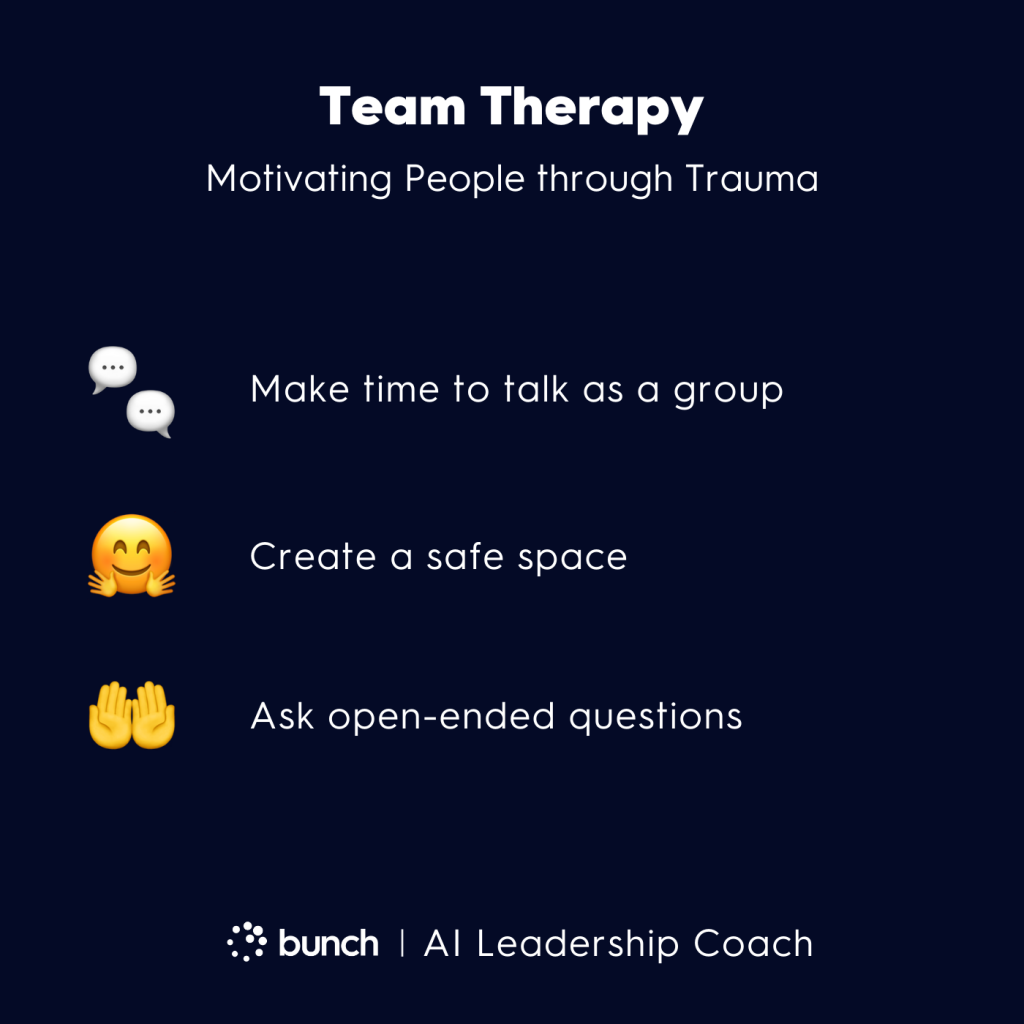
Here’s how you can apply this in your team:
Make time to talk as a group
Aim for at least one session a week (attendance is optional), and schedule 60-90 minutes to talk on video about how you’re all feeling. Ideally, it should be at the end of the day so people don’t feel pressure to get back to work afterward.
Create a safe space
Creating a feeling of safety is the only way this approach will work. Start the meeting with a quick introduction like this one:
“What will be talked about here has to stay confidential. In this room we are not CTO, Product Manager and Marketing Lead but rather Liz, Dean, and Sam. Going through this together will help us to come out stronger. Don’t shy away from sharing anything that challenges you, big or small. When responding to each other, it’s very important to refrain from judgment and be as empathetic as you can. While we’re all going through a similar thing, everyone’s experience is a bit different and personal. It’s important to respect that. Does that work for everyone?”
Ask open-ended questions
Try something like “What’s been challenging for you lately?” and take turns sharing. For most people, being open and being heard is already very helpful, even if the others can’t offer specific advice or solutions.
Pro Tip: You aren’t a professional therapist, and you shouldn’t feel the need to be one. A safe space, calm environment, and listening ears are already helpful for many people.
Once they’re able to heal a bit from the trauma, they’ll naturally have more motivation and be more productive at work.
Want more tips on how to motivate your team? The Bunch AI Leadership Coach has hundreds! Try it free for 3 months.
Dealing with Shock and Disbelief
How do leaders deal with shock and disbelief within their teams?
When bad news hits, it feels easier to “bury our heads in the sand” than deal with grim realities. For example, people on your team may ignore the dangers of COVID-19, or refuse to acknowledge that the situation will affect them for more than a couple of weeks.
It’s hard to overcome feelings of distrust and disbelief if you’re relying on politicians or social media for all of your information. Your team needs a trusted source to provide them with credible news so they can fully understand the situation. You can provide this by giving regular updates — not just on the company’s response to COVID-19, but also on the broader context of the crisis.
Tip from the Bunch Coach: The Trusted Source
You can curate information and educational resources on issues like health, science, and government policy – even though it might feel like it’s beyond the scope of your role as a manager. Here’s how to implement this:
- Provide updates every week
- Create a dedicated channel to discuss the situation
- Document important policies and best practices in one place
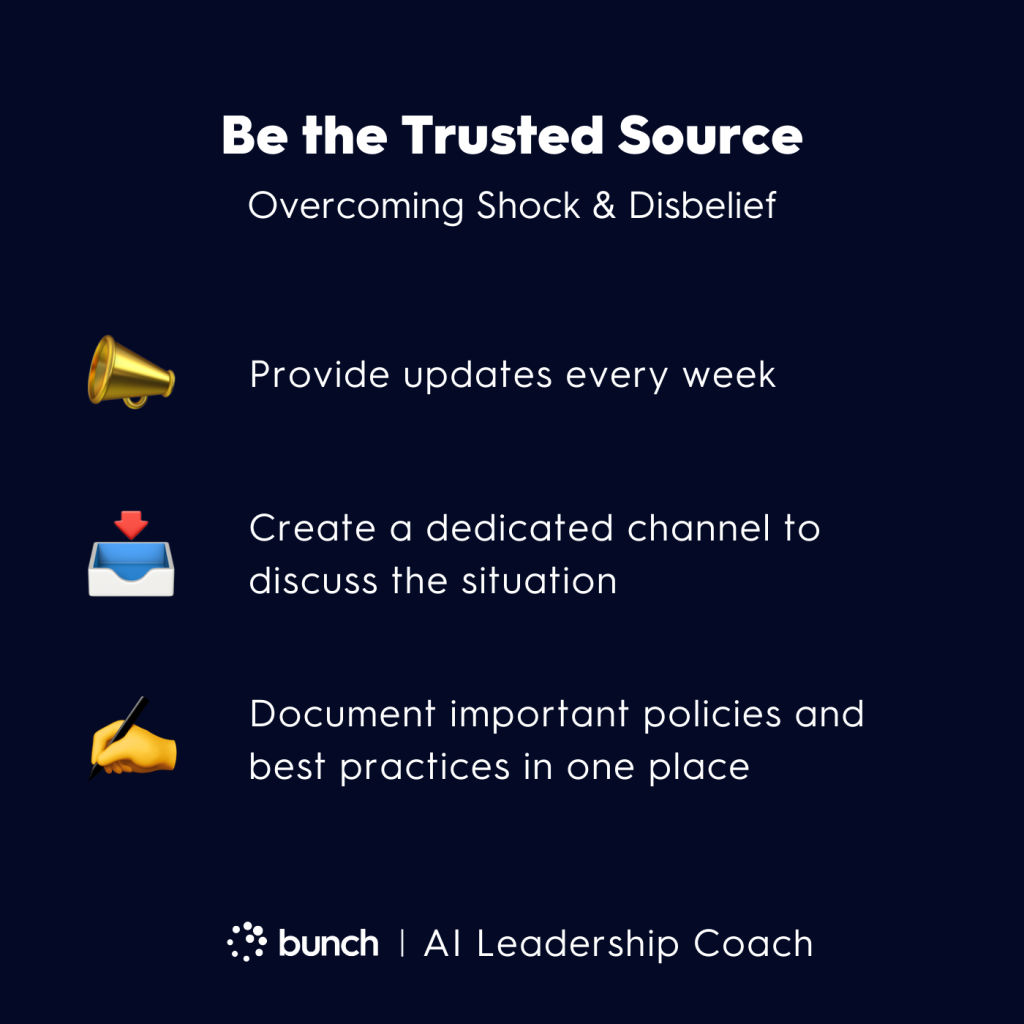
Let’s go through these one by one.
Provide updates every week
You can make your announcements in a team meeting, or Slack or email. Make sure to address questions like:
- What government guidance should everyone know about? Why is it important?
- What’s the latest information on how the crisis is developing?
Make sure to stick to sharing updates without fail. Even if there are no new updates, make sure to communicate this to your team.
Create a dedicated channel to discuss the situation
Have a dedicated place — like a Slack channel — to share statistics, news about social distancing guidelines or closures, and other developments. Try to avoid speculation here. Share facts only.
Document important policies and best practices in one place
Write down the latest work policies and best practices in a company wiki, like Notion. This can be anything from working from home guidelines, to remote communication principles, to health advice. It will help everyone have a single source to refer to.
If you follow these steps, you can give your team a trusted source of information, and help them overcome shock and disbelief during the COVID-19 pandemic.
Overcoming Helplessness
How can leaders help their teams overcome feelings of helplessness?
When bad things happen that are outside your control, it can make you feel helpless. You may lose belief in your own ability to make things happen or change the situation. Dealing with a global pandemic can certainly make this the case.
In a work context, helplessness can show up as people giving up or getting frustrated more easily.
Tip from the Bunch Coach: Take Action for Others
Overcoming that sense of helplessness often relies on finding ways to take action and impact the situation in some way — even if it’s relatively small. In the case of a global pandemic, it can feel tremendously empowering to volunteer your time and skills to help others.
As a leader, you should lead by example by taking action for others, but also encouraging the rest of your team to do so too. Here are a few to overcome helplessness:
- Research and share volunteering opportunities with your team
- Organize an event
- Debrief and brainstorm new ideas
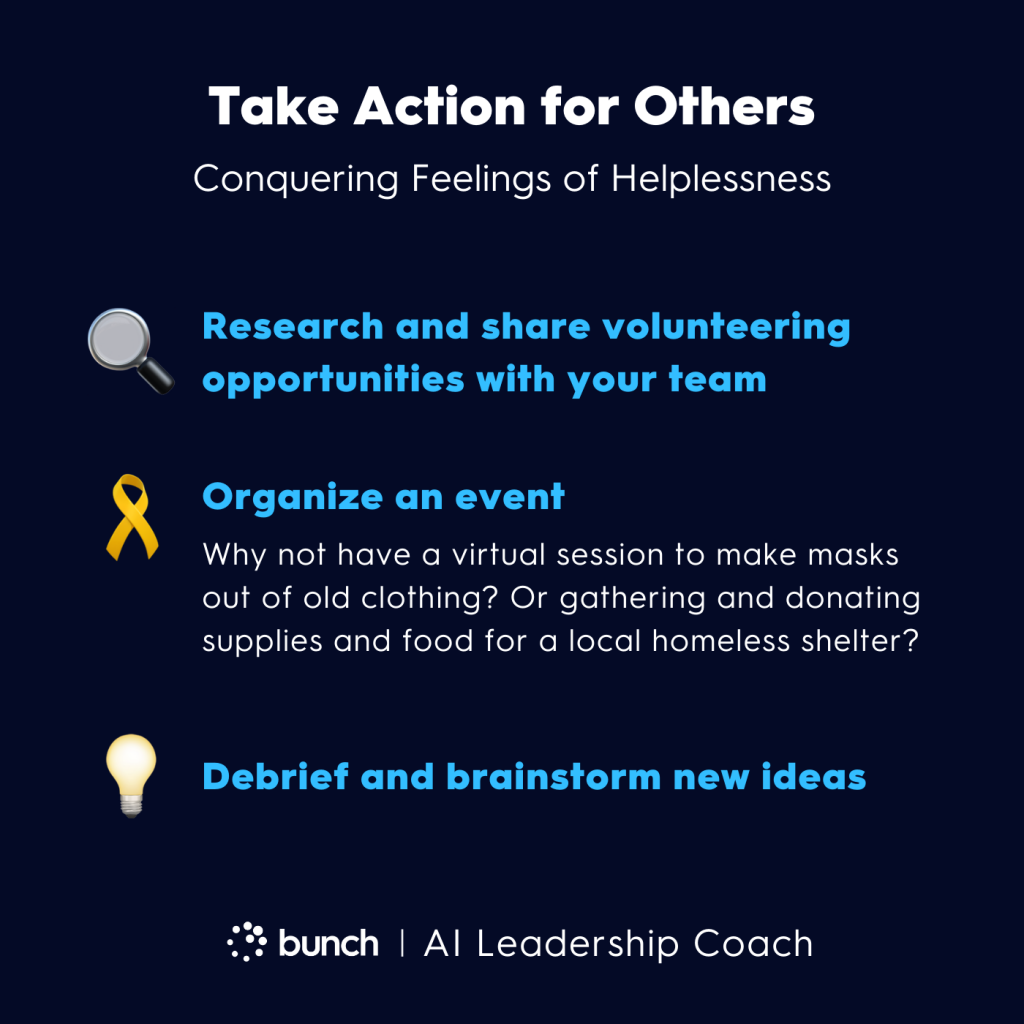
Let’s go through these one by one.
- Research and share volunteering opportunities with your team
From providing virtual companionship to people who are elderly or vulnerable, to raising food donations – find opportunities for your team to help out. - Organize an event
Why not have a virtual session to make masks out of old clothing? Or gathering and donating supplies and food for a local homeless shelter? Don’t worry about doing this in work time. The positive impact will do wonders for you and your team. - Debrief and brainstorm new ideas
Hold a session with your team to reflect on their volunteering efforts and how it made them feel. Then gather ideas on what they can do next. - Debrief and brainstorm new ideas
Hold a session with your team to reflect on their volunteering efforts and how it made them feel. Then gather ideas on what they can do next.
And there you have it – how to take action for others to reduce your own feeling of helplessness.
Getting through Shame and Guilt
How can leaders of teams manage feelings of shame and guilt?
We all want to feel like true pros that can handle anything. So when you’re not as productive as usual during a traumatic experience like the COVID-19 crisis, it can cause feelings of guilt and shame.
When this happens, the only way to get back to normal is to accept those feelings and encourage your team to do the same.
Tip from the Bunch Coach: The Coaching Catalyst
You can lead by example and help your team heal. One of the best ways to do this is to run a Live Coaching session with the team, on video, where you acknowledge your own feelings publicly. This will show your team a very different side of you – plus, it helps them open up and work through their own emotions.
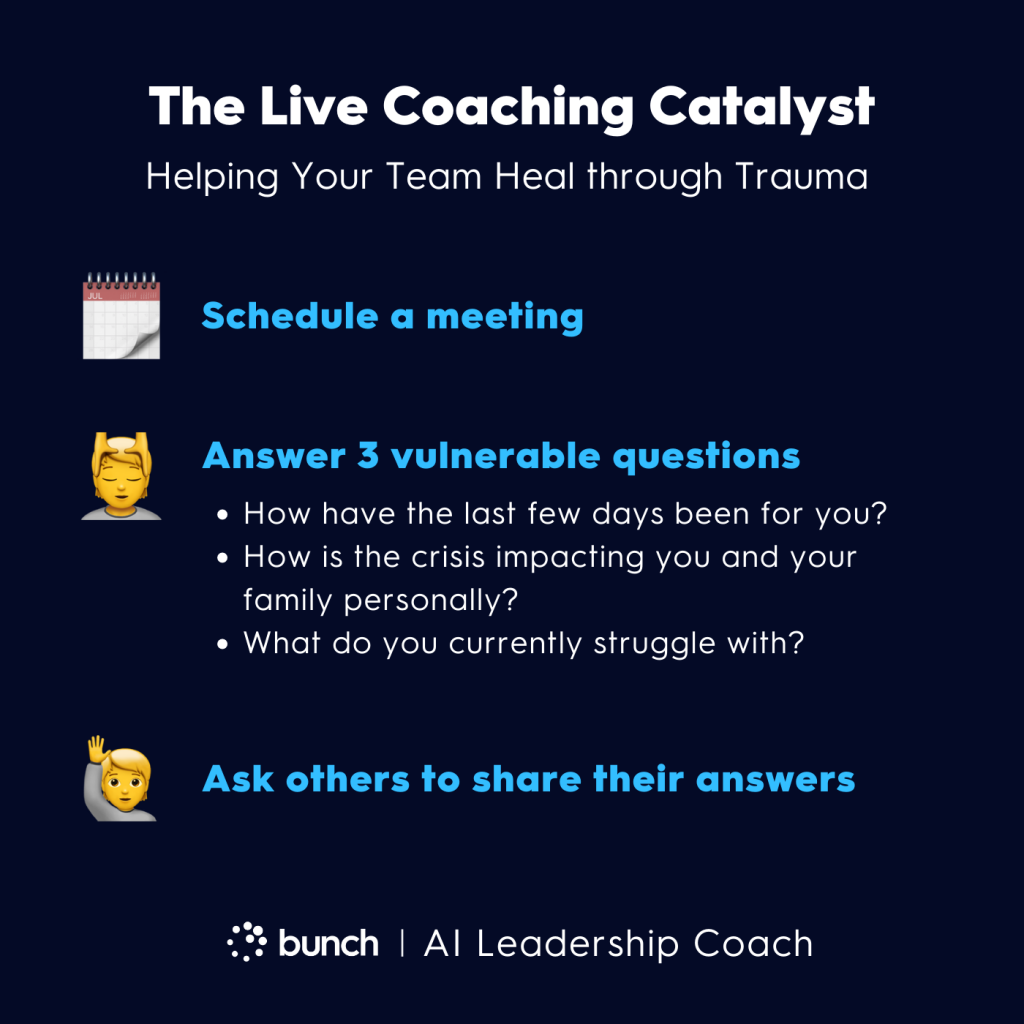
Here’s how you can run a live coaching session with your team:
1.Schedule a meeting with your team to talk about how everyone is feeling. Give it at least an hour, and ideally, arrange it for the end of the day so that people are not watching the clock and feeling pressured to get back to work.
2. Answer 3 vulnerable questions.
Offer to start. Have a team member you trust to ask you 3 questions:
- How have the last few days been for you?
- How is the crisis impacting you and your family personally?
- What do you currently struggle with?
Make sure to answer these questions in front of the group. Once you’ve shared:
3. Ask others to share their answers. Take turns to answer the same 3 questions. While not everyone will be ready to open up, the ones who do will feel much better, and it will deepen the trust in the team. For those who aren’t able to just yet, reassure them that it’s okay. If they ever feel like talking, they can drop you a message or call you at any time
Pro tip: Make this a weekly session during ongoing traumatic events like the COVID-19 pandemic.
And there you have it – try Live Coaching to catalyze an environment of healing through trauma. Remember Schedule a meeting, answer 3 vulnerable questions and ask others to share their answers.
Managing fear and anxiety
How do leaders help team members control fear and anxiety?
Fear is a normal reaction to a traumatic experience – and for many, the COVID-19 crisis has already created serious trauma. When someone’s afraid, they tend to obsess over the situation, spread negative news and speculate on what will go wrong. This makes it hard to focus and can affect the rest of the team.
Excessive exposure to images of a disturbing event —such as repeatedly viewing video clips on social media or news sites— can create traumatic stress in people who are not directly affected by the event.
Tip from the Bunch Coach: Eliminating Excess Exposure
So if you or someone on your team is afraid, one strategy to regain control is to limit your exposure to it. In the case of Coronavirus, that means being thoughtful about how and when to expose yourself to social media and news.
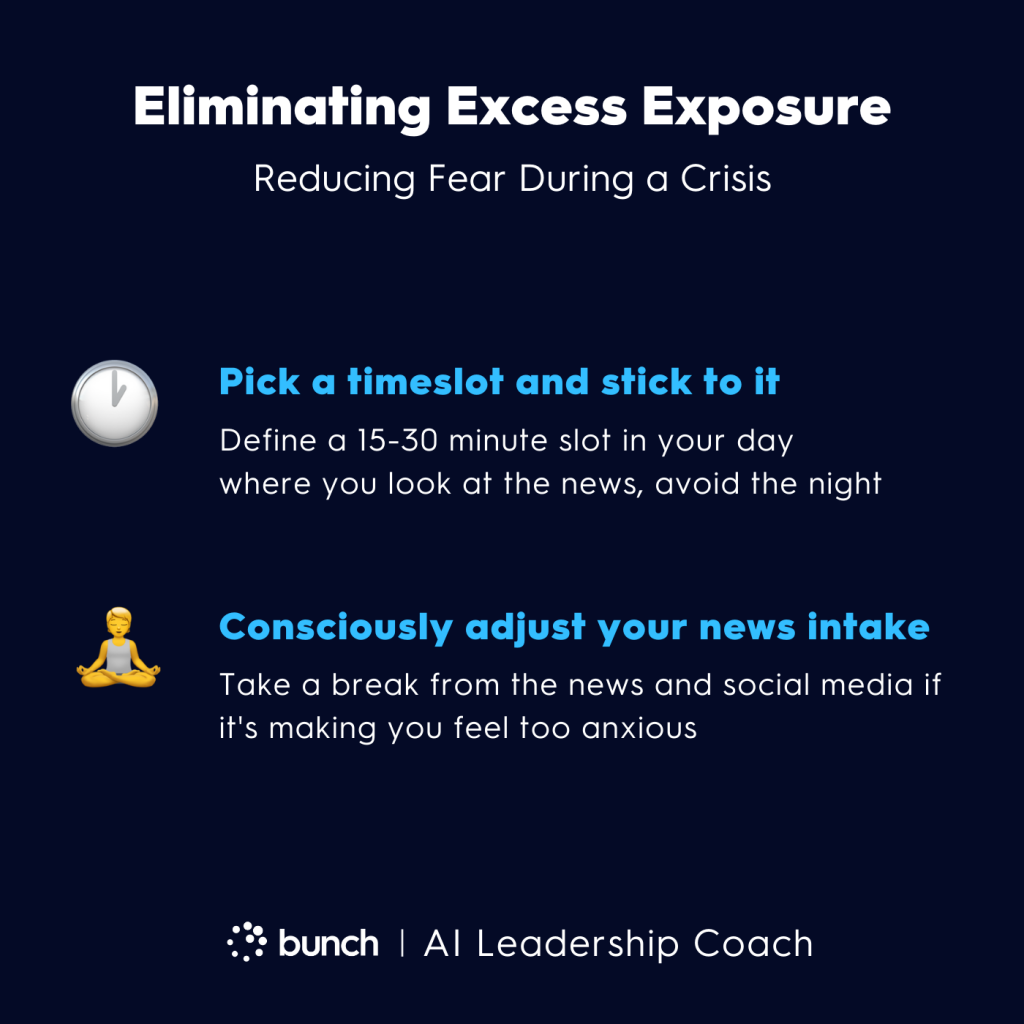
Here’s how you – or any member of your team – can do this:
- Pick a timeslot for news and stick to it
It’s often best to define a 15-30 minute slot in your day where you look at the news. Then try to avoid it for the rest of the day. To make sure you don’t disrupt your sleep, it’s often best to do this in the afternoon, not at night.
- Consciously adjust your news intake
Over the course of a few days, try to find the right balance so that you’re informed, but not triggered to the point of feeling constantly anxious. It’s often worth it to take a break from the news and social media for a few days or weeks until your stress symptoms ease up.
Pro Tip: not everyone on your team will realize how it affects others when they share news or potentially traumatic content with their teammates. If someone is sharing negative news regularly, reach out and ask them to keep in mind that not everyone is able to cope with it on a constant basis. Instead, ask them to limit their sharing to specific channels where it’s expected.
And there you have it – how to address fear by eliminating excess exposure to traumatic content in the news and social media.
Leading through crisis
How do you lead teams through times of crisis, when you’re also under stress?
Being there for your team starts by being in a good place yourself. The Bunch AI Leadership Coach has hundreds of 2-minute tips for you on how to gain clarity and confidence to lead your team effectively. As an emergency response to the COVID-19 crisis, we’re making the coach available for free for 3 months.







